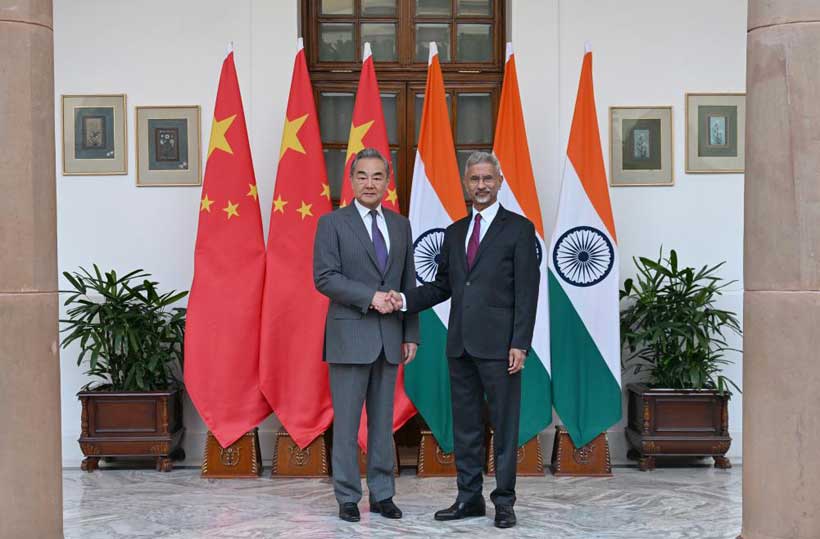Are the Sino-Indian Relations Heading Towards a Realignment?
At the invitation of India’s National Security Advisor Ajit Doval, China’s Foreign Minister Wang Yi paid an official visit to India on August 18th and 19th. The visit is being considered as a significant step for the restoration of Sino-Indian bilateral relations. On the first day of his visit, Wang Yi sat for a meeting with Indian Foreign Minister Subrahmanyam Jaishankar. In the meeting, Jaishankar stressed building a stable, cooperative, and forward-looking relationship between India and China, and differences between the two states must not turn into disputes. Then Wang Yi stressed that China and India should strengthen the momentum of improving bilateral relations, expand cooperation, and provide much-needed certainty and stability. The next day, Wang Yi met Ajit Doval to attend the 24th round of Border Talks. Both Doval and Wang emphasized maintaining peace and tranquility in the border areas for the well-being of the Sino-Indian bilateral relations. Before departure, Wang Yi called on the Indian Prime Minister Narendra Modi and handed over the invitation from China’s president to India’s prime minister for the Shanghai Cooperation Organization (SCO) Summit being held in Tianjin, China.
For some years, due to some issues, including border tensions, there has been a kind of coldness in the bilateral relations between the two states. Especially after the Galwan border clash in 2020, the bilateral relations between the two states turned highly complicated. Then both states had deployed a large military presence close to the border. In addition, both states imposed several sanctions on one another, including cutting off direct flights, visa restrictions, banning social media apps, etc.
The situation started to change last year when India’s Prime Minister Narendra Modi and China’s President Xi Jinping held a direct bilateral meeting at the BRICS summit in Kazan, Russia. This was the first direct meeting between the heads of the governments of the two states after the Galwan border clash. Since the meeting, both states have started withdrawing their troops from sensitive areas of the border. Some meetings have been held between officials from the foreign and security affairs of both states. Both parties have emphasized normalizing the relations between the two states and increasing cooperation. This was the first major move for the realignment of the Sino-Indian bilateral relations.
For the second major move, US President Donald Trump has played a big role. His reciprocal tariff policy has encouraged both India and China to come close. Trump imposed a 50% tariff on several key Indian products. On the other hand, China is also in discomfort with Trump’s trade policy, though negotiation with the US is still going on regarding tariff issues. It is creating pressure on the Chinese economy.
Despite the economy, Trump’s geopolitical strategy is also pushing India and China to walk in an aligned way. After the Pahelgam attack, India did not get expected support from the US. Rather, Pakistan has gotten an advantage from the US, including a lower tariff than India and a warm reception of Pakistan’s Army Chief, Field Marshal Asim Munir, in Washington and Tampa back-to-back within two months after the Pahelgam attack.
On the other hand, China has huge discomfort with the Indo-Pacific Strategy (IPS) of the US. Through the Quad alliance, the US is trying to create pressure on China’s supply chain in the Indo-Pacific region. China’s dispute with the US over Taiwan is on the way to growing. In addition, the growing US military presence in the South China Sea has become a major concern for China.
From there, it can be well understood that the US’s tariff policy and geopolitical strategy have become a common issue of discomfort for both India and China at this moment. As a result of all of these, the two immediate neighboring states have started to realize that partnership rather than rivalry between them can be useful for their mutual benefit.
As part of the partnership, both states have already started to take several initiatives. Both states have agreed to operate direct flights between them. Visa restriction is taking back from both sides. China has agreed to supply fertilizer and a Tunnel Boring Machine (TBM) to India. Recently China has allowed resuming the Kailash Manasarovar Yatra for Indian pilgrims. India has agreed to open its market for Chinese investment. According to a Reuters report, China promises to address India’s rare earth mineral needs.
Last month Indian Foreign Minister Subrahmanyam Jaisankar visited China to attend the Shanghai Cooperation Organization foreign ministers’ summit. This was Jaisankar’s first China visit after the border clash.Now China’s Foreign Minister Wang Yi has made a visit to India. In the call with Wang Yi, Narendra Modi confirmed that he will visit China to attend the Shanghai Cooperation Organization (SCO) Summit at the end of August.High officials’ visits like these indicate the intention and effort to normalize relations from both sides.
While the apparent initiatives taken by the two states for the realignment of the bilateral relations should be considered in a positive way. But it must be kept in mind that there are several major and complex obstacles standing in the way of a complete stabilization of the relationship between the two states. For example, just as India is uneasy about China’s Dalai Lama and Pakistan policy, on the other hand, China is also uneasy about India’s expansion of regional influence and effective involvement in the Quad alliance. In addition, there is still no stable solution to the border problem. In this scenario, both states have to come forward with equal effort and willingness for their mutual benefit.
A stable and cooperative Sino-Indian relationship has far-reaching benefits not only for both states but also beyond. Regional and global economic growth, security, and connectivity are deeply intertwined with the activities of these two states. Economically, China is the world’s second largest economy, and India is the fifth largest. In terms of military strength, China is the third and India is the fourth. Besides, both states are the most populous states in the world. Therefore, if these two states can resolve their differences through diplomatic means and move forward together in partnership, it will bring mutual prosperity not only to them but also to the regional and global scales. For this, realignment between the bilateral relations of the two states is highly required. Recent visits and several initiatives taken by the two states can be considered as significant moves of the realignment. And if the realignment takes place properly, then Dragon and Elephant can dance together.

